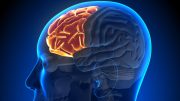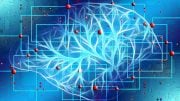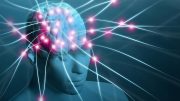
The study by Kep Kee Loh and Dr. Ryota Kanai found that grey-matter density in the highlighted region of the brain (anterior cingulate cortex) was negatively associated with the amount of media multitasking activity. Credit: University of Sussex
New research from the University of Sussex shows that people who frequently use several media devices at the same time have lower grey-matter density in one particular region of the brain compared to those who use just one device occasionally.
Simultaneously using mobile phones, laptops, and other media devices could be changing the structure of our brains, according to new University of Sussex research.
A study published in PLOS ONE reveals that people who frequently use several media devices at the same time have lower grey-matter density in one particular region of the brain compared to those who use just one device occasionally.
The research supports earlier studies showing connections between high media-multitasking activity and poor attention in the face of distractions, along with emotional problems such as depression and anxiety.
But neuroscientists Kep Kee Loh and Dr. Ryota Kanai point out that their study reveals a link rather than causality and that a long-term study needs to be carried out to understand whether high concurrent media usage leads to changes in the brain structure, or whether those with less-dense grey matter are more attracted to media multitasking.
The researchers at the University of Sussex’s Sackler Center for Consciousness Science used functional magnetic resonance imaging (fMRI) to look at the brain structures of 75 adults, who had all answered a questionnaire regarding their use and consumption of media devices, including mobile phones and computers, as well as television and print media.
They found that, independent of individual personality traits, people who used a higher number of media devices concurrently also had smaller grey matter density in the part of the brain known as the anterior cingulate cortex (ACC), the region notably responsible for cognitive and emotional control functions.
Kep Kee Loh says: “Media multitasking is becoming more prevalent in our lives today and there is increasing concern about its impacts on our cognition and social-emotional well-being. Our study was the first to reveal links between media multitasking and brain structure.”
Scientists have previously demonstrated that brain structure can be altered upon prolonged exposure to novel environments and experiences. The neural pathways and synapses can change based on our behaviors, environment, emotions, and can happen at the cellular level (in the case of learning and memory) or cortical re-mapping, which is how specific functions of a damaged brain region could be re-mapped to a remaining intact region.
Other studies have shown that training (such as learning to juggle, or taxi drivers learning the map of London) can increase grey-matter densities in certain parts of the brain.
“The exact mechanisms of these changes are still unclear,” says Kep Kee Loh. “Although it is conceivable that individuals with small ACC are more susceptible to multitasking situations due to weaker ability in cognitive control or socio-emotional regulation, it is equally plausible that higher levels of exposure to multitasking situations leads to structural changes in the ACC. A longitudinal study is required to unambiguously determine the direction of causation.”
Reference: “Higher Media Multi-Tasking Activity Is Associated with Smaller Gray-Matter Density in the Anterior Cingulate Cortex” by Kep Kee Loh and Ryota Kanai, 24 September 2014, PLOS One.
DOI: 10.1371/journal.pone.0106698









A person born about 50 years ago, had no appliances to do arithmetic calculations, and he was an expert in multiplication table and fraction tables. Similarly, even earlier, when mathematics was not so important, people were good at language skills, like William Shakespeare, who had no formal education,or Rabindranath Tagore of India. There were so many poets
in older days in any language for that matter whether in Tamil (a very ancient language) or Sanskrit, Greek or English. This I am quoting because there were no multitask in the brain rather than single much improved task of a subject. The grey matter of the brain was more in learning skill to the deepest depths. Pythogoras and Archimedes were best examples of ancient brains excelling in single task. When multitasks are performed by the brain, it needs helping gadgets and the brain work becomes less and less and the skill of manouvering the tasks only succeeds. Here grey matter is not actually used predominantly and after all if you don’t use any organ it you are losing it is the dictum of science. Thank You.